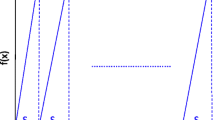Abstract
The proposed encryption technique uses Chinese Remainder Theorem (CRT) and hash map to generate and distribute secret co-prime keys to participants. It utilizes the fact that CRT gives a unique solution for the set of congruent equations if and only if the modulus values are relatively co-prime to each other i.e., Greatest Common Divisor (GCD) of moduli is equal to 1. In this paper, we have proposed secret image sharing scheme using CRT and obtained results on grayscale images of different dimensions. The proposed technique not only increases randomness in encrypted image but also compresses the image, resulting in easy storage and fast transmission. As compression ratio is dependent on shared keys, all shared keys are essential for recovering image without any noise, absence of any key gives an image which is deviated from our original image. For r participants, r pixels are encrypted and compressed simultaneously at a time using CRT which gives one encrypted unique value corresponding to those r pixels. As this encrypted value can be greater than 255, hash map is used to store this value. The experimental results show that the encrypted image is compressed, is not disclosing any secret information and recovery of original image is loss-less.










Similar content being viewed by others
Explore related subjects
Discover the latest articles and news from researchers in related subjects, suggested using machine learning.References
Adi S (1979) How to share a secret. Commun ACM 22.11:612–613
Chen G, Mao Y, Chui C (2004) A symmetric image encryption scheme based on 3D chaotic cat maps. Chaos, Solitons Fractals 21(3):749–761
Deshmukh M, Nain N, Ahmed M (2016) Enhanced modulo based multi secret image sharing scheme international conference on information systems security. Springer, Berlin
Deshmukh M, Nain N, Ahmed M (2016) An (N, n)-multi secret image sharing scheme using boolean XOR and modular arithmetic. 2016 IEEE 30th International Conference on Advanced Information Networking and Applications (AINA). IEEE
Deshmukh M, Nain N, Ahmed M (2017) A Novel Approach of an (n, n) Multi-Secret Image Sharing Scheme Using Additive Modulo. Proceedings of International Conference on Computer Vision and Image Processing. Springer, Singapore
Deshmukh M, Nain N, Ahmed M (2017) A novel approach for sharing multiple color images by employing Chinese Remainder Theorem. J Vis Commun Image Represent 49:291–302
Deshmukh M, Nain N, Ahmed M (2018) Efficient and secure multi secret sharing schemes based on boolean XOR and arithmetic modulo. Multimed Tools Appl 77.1:89–107
Deshmukh M, Nain N, Ahmed M (2018) Secret sharing scheme based on binary trees and Boolean operation. Knowl Inf Syst:1–20. https://doi.org/10.1007/s10115-018-1268-9
Huang R, Sakurai K (2011) A Robust and Compression-combined Digital Image Encryption Method Based on Compressive Sensing. Seventh International Conference on Intelligent Information Hiding and Multimedia Signal Processing
Liu Y, Nie L, Liu L, Rosenblum D (2015) From action to activity: Sensor-based activity recognition. Elsevier Neurocomputing 181:108–115
Liu Y, Nie L, Han L, Zhang L, Rosenblum D (2016) Action2Activiy: Recognizing Complex Activities from Sensor Data
Liu Y, Zhang L, Nie L, Yan Y, Rosenblum D (2016) Fortune Teller: Predicting Your Career Path. In: Proceedings of the Thirtieth AAAI Conference on Artificial Intelligence (AAAI-16)
Lyu W-L, Chang C-C, Wang F (2015) Color PNG image authentication scheme based on rehashing and secret sharing method. J Inform Hiding Multimed Signal Process 6(3):523–533
Maniccam S, Bourbakis N (2001) Lossless image compression and encryption using SCAN. Pattern Recogn 34(6):1229–1245
Mao Q, Bharanitharan K, Chang C (2016) Novel lossless morphing algorithm for secret sharing via meaningful images. J Inform Hiding Multimed Signal Process 34 (6):1229–1245
Orsdemir A, ALtun HO, Sharma G, Bocko MF (2008) On the security and robustness of encryption via compressed sensing. In: IEEE Military communications conference, 2008 (MILCOM 2008). IEEE, Rochester, pp 1–7
Preotiuc-Pietro D, Liu Y, Hopkins DJ, Ungar L (n.d.) Beyond Binary Labels: Political Ideology Prediction of Twitter Users
Rajput M, Deshmukh M (2016) Secure (n, n + 1)-multi secret image sharing scheme using additive modulo. Proced Comput Sci 89:677–683
Shivani S (2017) Multi secret sharing with unexpanded meaningful shares. Multimed Tools Appl 77(5):6287–6310
Thien CC, Lin JC (2002) Secret image sharing. Comput Graph 26(5):765–770
Zhang M, Tong X (2017) Joint image encryption and compression scheme based on IWT and SPIHT. Opt Lasers Eng 90:254–274
Zhou N, Zhang A, Zheng F, Gong L (2014) Novel image compression-encryption hybrid algorithm based on key-controlled measurement matrix in compressive sensing. Opt Laser Technol 62:152–160
Zhou N, Pan S, Cheng S, Zhou Z (2016) Image compression-encryption scheme based on hyper-chaotic system and 2D compressive sensing. Opt Laser Technol 82:121–133
Author information
Authors and Affiliations
Corresponding author
Additional information
Publisher’s note
Springer Nature remains neutral with regard to jurisdictional claims in published maps and institutional affiliations.
Rights and permissions
About this article
Cite this article
Duseja, T., Deshmukh, M. Image compression and encryption using chinese remainder theorem. Multimed Tools Appl 78, 16727–16753 (2019). https://doi.org/10.1007/s11042-018-7023-0
Received:
Revised:
Accepted:
Published:
Issue Date:
DOI: https://doi.org/10.1007/s11042-018-7023-0
Keywords
Profiles
- Maroti Deshmukh View author profile




